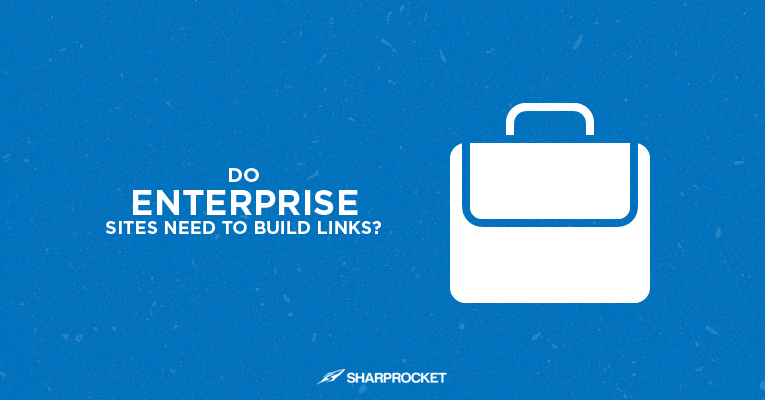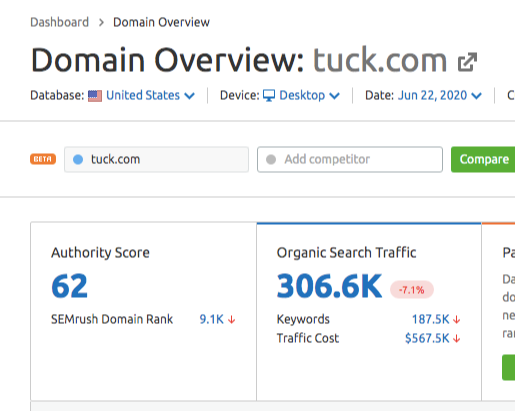by Venchito Tampon Jr | Last Updated on October 24, 2021
Enterprise link building is a different landscape. It requires a need for planning and knowing what expected results you want from a link acquisition campaign.

In today’s post, we’ll cover the need to build links for enterprise sites and understand what types of backlinks that will bring high brand value to them.
Do Enterprise Sites Need to Build Links?
The quick answer is yes.
Essentially, big enterprise sites are getting organic links, even without the manual link building campaigns.
Given their high-level top of the funnel and mid of the funnel content pieces, enterprise brands earn various types of links that bring more backlink growth than most small to medium business sites get.
However, most enterprise brands are not just waiting for links to come, but rather are more active in pursuing links. This is what we want to dig deeper a little bit — as to what types of links enterprises should be building for their sites.
Considerations When Building Links for Enterprise Sites
Since we are working with enterprise brands, we know what they’re usually after in a link building campaign and what they do get out of it.
For many SEO and link building agencies, they know that once these enterprises’ director of marketing or director of SEO reached out to them, these people know what to actually look for.
Though some may take some serious study and may need to be educated on why SEO matters to them, most enterprise clients who reached out have a good understanding of their needs.
Targeted Types of Pages
To be more effective in an enterprise link building campaign, one has to know the types of pages he/she should start prioritizing from the very start.
Generally, the focus of driving links are into core product pages — these are product pages that convert so well from sales and leads standpoint, but maybe struggling to get a ton of links.
To find viability for links, enterprise SEO teams will have supporting content guides internally linking to these product pages. These supporting pages will be used now as the value proposition to garner blog links or editorial links straight to them.
Another strategy is to add more informational elements (we call it as citable elements) to landing pages, such as product pages. By doing so, you get to serve a specific group of linkable audience and thus increase the likelihood of getting high authority links.
There is no successful link building campaign that will spend lots of money on random links. Enterprise sites have targeted pages they consider as part of their link building strategy.
Quality VS Quantity
Enterprise sites are aiming for both quantity and quality of links. They want to drive more, but highly relevant and authoritative links.
These authoritative links may have different benchmark metrics depending on which agency they’re partnering with.
All backlink prospects should be relevant to the brand’s content theme. It may be coming from industries, but sites that have engaged audiences enterprises cater to.
Besides relevance, metrics that I’ve found to get more buy-in from enterprise sites is the website’s organic traffic, traffic cost, and brand value.
SEMRush helps you show websites’ organic traffic and traffic cost. This gives you an idea if the website gets constant visibility from ranking pages on search — providing you with more referral visitors to your site.

Brand value is also a key factor to consider in prospecting for relevant authoritative websites. This refers to how you see the potential linking site to give you better returns in branding impression as you go and get links from it.
Link Value Ratio
One of the big problems of many enterprise brands is not considering the link value ratio when executing a link acquisition campaign.
If you spend big budgets to build links to target pages that don’t have any ranking and money potentials, you’ll miss out on great opportunities that should’ve been invested in other content marketing initiatives.
Here is a great reference by Ross Hudgens that shows you how to compute for link value ratio.
Tactical Link Building for Enterprise Sites
A. Internal Linking
Oftentimes enterprise-level sites overlook their ability to leverage their internal linking capabilities. Their hundreds or thousands of pages can make wonders in terms of getting “quick wins” that they could have missed earlier if they proceeded right away to traditional link building.
Build internal links to funnel link equity to your most important pages. There are different ways to attack this one, and I recommend available resources below:
B. Link Reclamation
One of the best things to leverage in an enterprise site is its ability to capture the unlinked brand mentions from many sources.
A product worth mentioning on a blog post, a press release about your latest product feature, an interview about your executive about the changes happening in your company (or in your industry) are just some of the things you can monitor on a regular basis.
You can reach out to relevant publishers, content creators, or bloggers who mentioned any of your brand content (has your unlinked brand mentions) on their pages.
Get them to link to the most relevant page on your site.
If you’re looking for a detailed process on this link building strategy, you can check out my guide on link reclamation.
C. Strategic Content Partnerships
As a link building company working with enterprise clients, what we’ve found to be a unique proposition for big brands is their pool of partners.
Those partners that they’ve built over the years can help set up collaborations much easier than usual.
Strengthen the brand more by associating it with well-liked entities. You can collaborate with other well-known content creators in producing a linkbait piece of content targeted to specific audiences.
Through content collaboration, you capture each of the content partner’s followers and readers.
Another way to build high-value blog links is to create connections with authors who write for multiple websites about your industry.
These are authors who develop their personal brands to disseminate their messages in content by submitting guest posts to top-niche blogs.
So instead of the traditional guest blogging where you blast out distributed content to different blogs, you put your brand in a position where these guest authors come to you for links (link earning).
D. Reverse Outreach Campaigns
Reverse outreach is a strategy enterprise brands can take advantage of.
Instead of solely doing direct outreach to relevant publishers and content creators for external content distribution, they can leverage the power of linkbaiting — creating high-value pages to earn authority backlinks.
Since brands have strong domain power, they can rank pages for keywords in a short period of time.
One link building technique (earlier been mentioned) is the idea of inviting influential content creators to contribute and/or collaborate content for your blog.
The beauty of it is that you gain new expertly-crafted content pieces every now and then. You also acquire new links from these guest posts as they reference it (or externally link to it) from their other externally distributed content (guest posts).
Create more interesting content assets on your blog to attract links from relevant publishers as well as receive more targeted pitches from guest authors. Well then, you have your set of rules to select only practitioners who can write for your blog.
Having a reverse outreach strategy in place will keep you earning links consistently to your site.
Maximize Your Strengths As An Enterprise Site
There are many competitive advantages of running a link building campaign for an enterprise brand. With proper research and planning on highly performing linkable assets to inform future content creation decisions can help get low-hanging fruits of links.
Are you currently building links to enterprise site/s? Share any other link building tips in the comments below.
The Author
Venchito Tampon Jr
Venchito Tampon is a Filipino Motivational Speaker, Corporate Trainer, and a Leadership Speaker in the Philippines. He is the CEO and Co-Founder of SharpRocket, a link building agency. With a decade of experience, Venchito has a proven track record of leading hundreds of successful SEO (link builidng) campaigns across competitive industries like finance, B2B, legal, and SaaS. His expert advice as a link building expert has been featured in renowned publications such as Semrush, Ahrefs, Huffington Post and Forbes. He is also an international SEO spoken and has delivered talks in SEO Zraz, Asia Pacific Affiliate Summit in Singapore, and Search Marketing Summit in Sydney, Australia. Check out his other businesses, Hills & Valleys Cafe, Blend N Sips and Saas Pursuit.
How our LINK BUILDING AGENCY builds 250 links/mo consistently using Predictable Link Building Methodology™…
- Using a SIMPLE and PROVEN system
- Using a SCALABLE strategy
- No private blog networks
- No creepy outreach emails
